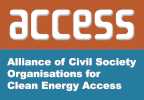Difference between revisions of "Lessons from the Edge"
From energypedia
***** (***** | *****) m |
***** (***** | *****) |
||
| (3 intermediate revisions by the same user not shown) | |||
| Line 1: | Line 1: | ||
| − | |||
[[File:MES Berkley small.png|center|800px|Innovating Energy Access for Remote Areas: Discovering Untapped Resources|alt=Innovating Energy Access for Remote Areas: Discovering Untapped Resources|link=Innovating Energy Access for Remote Areas: Discovering Untapped Resources]] | [[File:MES Berkley small.png|center|800px|Innovating Energy Access for Remote Areas: Discovering Untapped Resources|alt=Innovating Energy Access for Remote Areas: Discovering Untapped Resources|link=Innovating Energy Access for Remote Areas: Discovering Untapped Resources]] | ||
| Line 28: | Line 27: | ||
<br/> | <br/> | ||
| − | == | + | == Issues Presented == |
| − | |||
| − | |||
| − | |||
| − | |||
| − | |||
| − | |||
| − | |||
| − | |||
| − | |||
| − | |||
| − | |||
| − | |||
| − | |||
| − | |||
| − | |||
| − | |||
| − | |||
| − | |||
| − | |||
| − | |||
| − | |||
| − | |||
| − | |||
| − | |||
| − | |||
| − | |||
| − | |||
| − | |||
| − | |||
| − | |||
| − | |||
| − | |||
| − | |||
| − | |||
| − | |||
| − | |||
| − | |||
| − | |||
| − | |||
| − | |||
| − | + | <span style="color: rgb(139, 45, 45); font-size: 12px; line-height: 21px;">► </span><span style="background-color: rgb(255, 255, 255); font-size: 12px; line-height: 21px;">[[:File:Lessons from the Edge.pdf|Please see the presentation.]]</span> | |
| − | + | *Afghanistan, US Military | |
| − | + | *Difficult to deliver supplies to rural bits | |
| − | + | *Discovered that human capital expense was immense | |
| − | + | *There was a lot of loss of goods, In addition to loss of human life | |
| − | + | *Initially, people were resistant to idea of renewables as they were too heavy, unfamiliar, and not “trusted” on the ground, etc.. Thus making the case for renewables use took some time. | |
| − | + | *Worked with groups outside of the US Govt | |
| + | **Found that groups that were actually using the technologies, were the best to work with | ||
| + | **They deployed some great technologies that are very sustainable, and appropriate for outposts | ||
| + | **Reduction in exposure to combat | ||
<br/> | <br/> | ||
| − | + | == Q & A == | |
| − | |||
| − | |||
| − | |||
| − | |||
| − | |||
| − | |||
| − | |||
| − | |||
| − | |||
| − | |||
| − | + | 1. How do you calculate the cost of a barrel of fuel?<br/> | |
| + | *Its pretty immense ( in the thousands) | ||
| + | *The discussion of human capital seems to have changed the conversation in congress (as opposed to economics)<br/> | ||
| − | + | 2. How much of the system was designed specifically for the application?<br/> | |
| + | *They worked with a collection of suppliers and made slight modifications to civilian projects. | ||
| − | + | 3. How can we learn from the military approaches (top down) and lots of capital for the rural applications (base of the pyramid)? | |
| + | *The military approach was in large part informed by rural innovations. The aim is to make sure that the military doesn't have to compete for resources with the local communities, for water, fuel, etc. | ||
| − | + | 4. What equipment will stay in Afghanistan, and will it be re-purposed for local communities?<br/> | |
| + | *This is decided on a case by case basis and also depends on agreements with the host nation. Ultimately a decision is made by the state department, although a lot of other factors play into the decision. | ||
<br/> | <br/> | ||
Latest revision as of 12:36, 8 May 2014
Error creating thumbnail: File missing
Error creating thumbnail: File missing |
Error creating thumbnail: File missing |
Error creating thumbnail: File missing |
Error creating thumbnail: File missing |
Lessons from the Edge
Presenter: Peter Newell, (BMNT Partners, USA)
Overview
| Lessons learned by the Army in changing how it meets energy needs on the battlefield can well inform how energy solutions are brought to rural areas around the world.The high human cost of delivering energy on the battlefield led the Army to reexamine its assumptions about how energy is provided and used.Changing the way they framed the problem led to better energy solutions, saved lives, and made the missions more resilient.The resilience paradigm is also well suited to rural energy applications.Based on the Army’s lessons learned, the authors describe the attributes of a resilient system and discuss how these terms can be applied to instill energy resilience in rural communities[1]. | File:Lessons from the Edge.pdf |
Issues Presented
► Please see the presentation.
- Afghanistan, US Military
- Difficult to deliver supplies to rural bits
- Discovered that human capital expense was immense
- There was a lot of loss of goods, In addition to loss of human life
- Initially, people were resistant to idea of renewables as they were too heavy, unfamiliar, and not “trusted” on the ground, etc.. Thus making the case for renewables use took some time.
- Worked with groups outside of the US Govt
- Found that groups that were actually using the technologies, were the best to work with
- They deployed some great technologies that are very sustainable, and appropriate for outposts
- Reduction in exposure to combat
Q & A
1. How do you calculate the cost of a barrel of fuel?
- Its pretty immense ( in the thousands)
- The discussion of human capital seems to have changed the conversation in congress (as opposed to economics)
2. How much of the system was designed specifically for the application?
- They worked with a collection of suppliers and made slight modifications to civilian projects.
3. How can we learn from the military approaches (top down) and lots of capital for the rural applications (base of the pyramid)?
- The military approach was in large part informed by rural innovations. The aim is to make sure that the military doesn't have to compete for resources with the local communities, for water, fuel, etc.
4. What equipment will stay in Afghanistan, and will it be re-purposed for local communities?
- This is decided on a case by case basis and also depends on agreements with the host nation. Ultimately a decision is made by the state department, although a lot of other factors play into the decision.
References
- ↑ Lessons from the Edge. Peter Newell, David Kerner and Scott Thomas.














